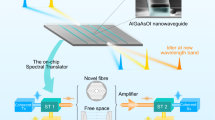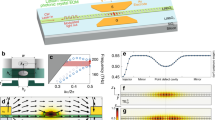Abstract
The ability to directly modulate a nanocavity laser with ultralow power consumption is essential for the realization of a CMOS-integrated, on-chip photonic network, as several thousand lasers must be integrated onto a single chip. Here, we show high-speed direct modulation (3-dB modulation bandwidth of 5.5 GHz) of an ultracompact InP/InGaAsP buried heterostructure photonic-crystal laser at room temperature by optical pumping. The required energy for transmitting one bit is estimated to be 13 fJ. We also achieve a threshold input power of 1.5 µW, which is the lowest observed value for room-temperature continuous-wave operation of any type of laser. The maximum single-mode fibre output power of 0.44 µW is the highest output power, to our knowledge, for photonic-crystal nanocavity lasers under room-temperature continuous-wave operation. Implementing a buried heterostructure leads to excellent device performance, reducing the active region temperature and effectively confining the carriers inside the cavity.
This is a preview of subscription content, access via your institution
Access options
Subscribe to this journal
Receive 12 print issues and online access
$209.00 per year
only $17.42 per issue
Buy this article
- Purchase on Springer Link
- Instant access to full article PDF
Prices may be subject to local taxes which are calculated during checkout






Similar content being viewed by others
References
Magen, N., Kolodny, A., Weiser, U. & Shamir, N. Interconnect-power dissipation in a microprocessor. Proc. 2004 Int. Workshop System Level Interconnect Prediction, Session Interconnect Anal. SoCs Microprocess., 7–13 (2004).
Vlasov, Y., Green, W. M. J. & Xia, F. High-throughput silicon nanophotonic wavelength-insensitive switch for on-chip optical networks. Nature Photon. 2, 242–246 (2008).
Shacham, A., Bergman, K. & Carloni, L. P. Photonic networks-on-chip for future generations of chip multiprocessors. IEEE Trans. Comput. 57, 1246–1260 (2008).
Miller, D. A. B. Device requirements for optical interconnects to silicon chips. Proc. IEEE 97, 1166–1185 (2009).
Tadokoro, T. et al. Operation of a 25-Gb/s direct modulation ridge waveguide MQW-DFB laser up to 85 °C. IEEE Photon. Technol. Lett. 21, 1154–1156 (2009).
Otsubo, K. et al. 1.3-μm AlGaInAs multiple-quantum-well semi-insulating buried-heterostructure distributed-feedback lasers for high-speed direct modulation. IEEE J. Sel. Top. Quant. Electron. 15, 687–693 (2009).
Chang, Y.-C. & Coldren, L. A. Efficient, high-data-rate, tapered oxide-aperture vertical-cavity surface-emitting lasers. IEEE J. Sel. Top. Quant. Electron. 15, 1–12 (2009).
Tanabe, T., Notomi, M., Kuramochi, E., Shinya, A. & Taniyama, H. Trapping and delaying photons for one nanosecond in an ultrasmall high-Q photonic-crystal nanocavity. Nature Photon. 1, 49–52 (2007).
Takahashi, Y. et al. High-Q nanocavity with a 2-ns photon lifetime. Opt. Express 15, 17206–17213 (2007).
Tanabe, T., Notomi, M., Mitsugi, S., Shinya, A. & Kuramochi, E. All-optical switches on a silicon chip realized using photonic crystal nanocavities. Appl. Phys. Lett. 87, 151112 (2005).
Shinya, A. et al. All-optical on-chip bit memory based on ultra high Q InGaAsP photonic crystal. Opt. Express 16, 19382–19387 (2008).
Nozaki, K. et al. All-optical switching with extremely-small control energy in InGaAsP-based photonic crystal nanocavity. 22nd Annual Meeting of the IEEE Photonics Society, MD3, Belek-Antalya, Turkey, 2009.
Loncâr, M. et al. Low-threshold photonic crystal laser. Appl. Phys. Lett. 81, 2680–2682 (2002).
Ryu, H. Y., Notomi, M., Kuramochi, E. & Segawa, T. Large spontaneous emission factor (>0.1) in the photonic crystal monopole-mode laser. Appl. Phys. Lett. 84, 1067–1069 (2004).
Baba, T. et al. Observation of fast spontaneous emission decay in GaInAsP photonic crystal point defect nanocavity at room temperature. Appl. Phys. Lett. 85, 3989–3991 (2004).
Purcell, E. Spontaneous emission probabilities at radio frequencies. Phys. Rev. 69, 681 (1946).
Altug, H., Englund, D. & Vučković, J. Ultrafast photonic crystal nanocavity laser. Nature Phys. 2, 484–488 (2006).
Notomi, M., Shinya, A., Mitsugi, S., Kuramochi, E. & Ryu, H. Y. Waveguides, resonators and their coupled elements in photonic crystal slabs. Opt. Express 12, 1551–1561 (2004).
Notomi, M., Kuramochi, E. & Tanabe, T. Large-scale arrays of ultrahigh-Q coupled nanocavities. Nature Photon. 2, 741–747 (2008).
Nomura, M. et al. Room temperature continuous-wave lasing in photonic crystal nanocavity. Opt. Express 14, 6308–6315 (2006).
Nozaki, K., Kita, S. & Baba, T. Room temperature continuous wave operation and controlled spontaneous emission in ultrasmall photonic crystal nanolaser. Opt. Express 15, 7506–7514 (2007).
Park, H.-G. et al. Electrically driven single-cell photonic crystal laser. Science 305, 1444–1447 (2004).
Shih, M. H. et al. Identification of modes and single mode operation of sapphire-bonded photonic crystal lasers under continuous-wave room temperature operation. Appl. Phys. Lett. 90, 121116 (2007).
Bagheri, M. et al. Linewidth and modulation response of two-dimensional microcavity photonic crystal lattice defect lasers. IEEE Photon. Technol. Lett. 18, 1161–1163 (2006).
Notomi, M. & Taniyama, H. On-demand ultrahigh-Q cavity formation and photon pinning via dynamic waveguide tuning. Opt. Express 16, 18657–18666 (2008).
Nomura, M., Iwamoto, S., Kumagai, N. & Arakawa, Y. Temporal coherence of a photonic crystal nanocavity laser with high spontaneous emission coupling factor. Phys. Rev. B 75, 195313 (2007).
Notomi, M., Shinya, A., Mitsugi, S., Kira, G., Kuramochi, E. & Tanabe, T. Optical bistable switching action of Si high-Q photonic-crystal nanocavities. Opt. Express 13, 2678–2687 (2005).
Björk, G. & Yamamoto, Y. On the linewidth of microcavity lasers. Appl. Phys. Lett. 60, 304–306 (1992).
Okumura, T. et al. Lateral current injection GaInAsP/InP laser on semi-insulating substrate for membrane-based photonic circuits. Opt. Express 17, 12564–12570 (2009).
Long, C. M. et al. Photonic crystal band edge diode light emitters. Proceedings of Indium Phosphide and Related Materials 2009 ThA2.3, 399–402 (2009).
Acknowledgements
The authors thank R. Urata, R. Takahashi and K. Kato for their technical support and discussions. We also thank T. Yamanaka and H. Saito for numerical simulation of the thermal relaxation and Y. Shouji for fabricating the device. Part of this work was supported by the National Institute of Information and Communications Technology (NICT).
Author information
Authors and Affiliations
Contributions
S.M. and M.N. conceived the idea and supervised the project. A.S., T.K. and K.N. designed the devices. S.M., T.S., T.S. and Y.K. fabricated the devices. S.M. and A.S. performed the measurements. S.M. and M.N. wrote the manuscript.
Corresponding author
Ethics declarations
Competing interests
The authors declare no competing financial interests.
Rights and permissions
About this article
Cite this article
Matsuo, S., Shinya, A., Kakitsuka, T. et al. High-speed ultracompact buried heterostructure photonic-crystal laser with 13 fJ of energy consumed per bit transmitted. Nature Photon 4, 648–654 (2010). https://doi.org/10.1038/nphoton.2010.177
Received:
Accepted:
Published:
Issue Date:
DOI: https://doi.org/10.1038/nphoton.2010.177
This article is cited by
-
Ultra-low threshold continuous-wave quantum dot mini-BIC lasers
Light: Science & Applications (2023)
-
Effect of Au substrate and coating on the lasing characteristics of GaAs nanowires
Scientific Reports (2021)
-
Ultra-coherent Fano laser based on a bound state in the continuum
Nature Photonics (2021)
-
Continuous-wave quantum dot photonic crystal lasers grown on on-axis Si (001)
Nature Communications (2020)
-
Demonstration of a self-pulsing photonic crystal Fano laser
Nature Photonics (2017)



